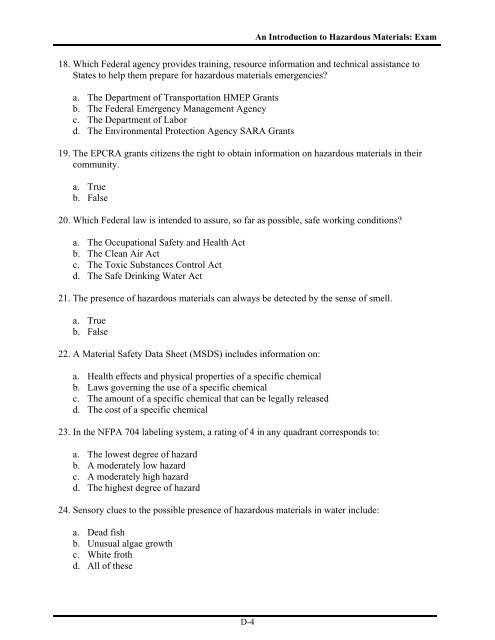An Introduction to Hazardous Materials: Exam - Emergency ...
An Introduction to Hazardous Materials: Exam - Emergency ...
An Introduction to Hazardous Materials: Exam - Emergency ...
You also want an ePaper? Increase the reach of your titles
YUMPU automatically turns print PDFs into web optimized ePapers that Google loves.
<strong>An</strong> <strong>Introduction</strong> <strong>to</strong> <strong>Hazardous</strong> <strong>Materials</strong>: <strong>Exam</strong><br />
18. Which Federal agency provides training, resource information and technical assistance <strong>to</strong><br />
States <strong>to</strong> help them prepare for hazardous materials emergencies?<br />
a. The Department of Transportation HMEP Grants<br />
b. The Federal <strong>Emergency</strong> Management Agency<br />
c. The Department of Labor<br />
d. The Environmental Protection Agency SARA Grants<br />
19. The EPCRA grants citizens the right <strong>to</strong> obtain information on hazardous materials in their<br />
community.<br />
a. True<br />
b. False<br />
20. Which Federal law is intended <strong>to</strong> assure, so far as possible, safe working conditions?<br />
a. The Occupational Safety and Health Act<br />
b. The Clean Air Act<br />
c. The Toxic Substances Control Act<br />
d. The Safe Drinking Water Act<br />
21. The presence of hazardous materials can always be detected by the sense of smell.<br />
a. True<br />
b. False<br />
22. A Material Safety Data Sheet (MSDS) includes information on:<br />
a. Health effects and physical properties of a specific chemical<br />
b. Laws governing the use of a specific chemical<br />
c. The amount of a specific chemical that can be legally released<br />
d. The cost of a specific chemical<br />
23. In the NFPA 704 labeling system, a rating of 4 in any quadrant corresponds <strong>to</strong>:<br />
a. The lowest degree of hazard<br />
b. A moderately low hazard<br />
c. A moderately high hazard<br />
d. The highest degree of hazard<br />
24. Sensory clues <strong>to</strong> the possible presence of hazardous materials in water include:<br />
a. Dead fish<br />
b. Unusual algae growth<br />
c. White froth<br />
d. All of these<br />
D-4

















